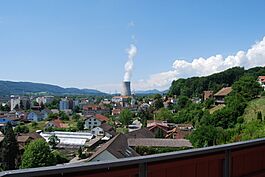Niedergösgen facts for kids
Quick facts for kids
Niedergösgen
|
||
|---|---|---|
 |
||
|
||
| Country | Switzerland | |
| Canton | Solothurn | |
| District | Gösgen | |
| Area | ||
| • Total | 4.32 km2 (1.67 sq mi) | |
| Elevation | 377 m (1,237 ft) | |
| Population
(Dec 2020 )
|
||
| • Total | 3,897 | |
| • Density | 902.1/km2 (2,336.4/sq mi) | |
| Postal code |
5013
|
|
| Surrounded by | Däniken, Gretzenbach, Lostorf, Niedererlinsbach, Obergösgen, Schönenwerd, Stüsslingen | |
Niedergösgen is a small town, also called a municipality, located in the Gösgen district of the canton of Solothurn in Switzerland. It's a charming place with a rich history and beautiful surroundings.
Contents
History of Niedergösgen
Niedergösgen was first mentioned in official records way back in 1294. At that time, it was known by a different name, Bözzach. A few years later, in 1308, it was called Göskon inferior. This shows how old the town is and how its name has changed over many centuries!
Geography of Niedergösgen
Niedergösgen covers an area of about 4.33 square kilometers (which is about 1.67 square miles). A big part of this land, about 26.1%, is used for farming. Forests cover another large portion, about 36.5% of the area, making it a very green place.
About 30.5% of the land is developed with buildings and roads, showing where people live and work. Rivers and lakes make up about 6.9% of the area. The town is located along the Aare river, which is an important waterway in Switzerland. Niedergösgen includes the main village and a smaller part called Mühledorf.
Niedergösgen's Coat of Arms
Every town has a special symbol called a coat of arms. It's like a unique flag or logo for the town. The coat of arms for Niedergösgen is described as Per bend Gules and Argent. This means it's divided diagonally into two colors: red (Gules) and silver or white (Argent).
Population and People
Niedergösgen has a population of about 3897 people. About 26.5% of the people living here are from other countries.
Most people in Niedergösgen speak German, which is the main language in this part of Switzerland. About 85.2% of the population speaks German. Other languages spoken include Italian (4.6%) and Serbo-Croatian (3.4%).
Many people have lived in Niedergösgen for a long time. In 2000, about 30.5% of the population were born in Niedergösgen itself. Others were born in the same canton (18.5%), elsewhere in Switzerland (27.3%), or outside of Switzerland (21.0%).
The age groups in Niedergösgen show a mix of people. About 7.3% are young children (0-6 years old), and 17.5% are teenagers (7-19 years old). The largest group, about 29.8%, are adults between 25 and 44 years old. There are also many older adults and seniors, showing a well-established community.
The chart below shows how the population of Niedergösgen has changed over many years:

Important Heritage Sites
Niedergösgen is home to some important historical buildings. The Church and Tower are listed as a Swiss heritage site of national significance. This means they are very important cultural treasures that are protected. The nearby village of Schönenwerd is also part of the Inventory of Swiss Heritage Sites, which means its entire historical area is recognized for its special value.
Economy and Jobs
In Niedergösgen, people work in many different types of jobs. The economy is divided into three main parts:
- Primary sector: This includes jobs related to farming and forestry. About 43 people work in this area.
- Secondary sector: This involves manufacturing and construction. About 493 people work in factories or building things.
- Tertiary sector: This is the largest sector and includes jobs in services, like shops, restaurants, healthcare, and education. About 498 people work in these kinds of jobs.
Many people who live in Niedergösgen travel to other towns for work. About 17.3% of the working population uses public transportation to get to their jobs, while 57% use a private car.
Religion in Niedergösgen
The people of Niedergösgen follow different religions. According to a 2000 survey:
- About 46.7% of the population are Roman Catholic.
- About 23.9% belong to the Swiss Reformed Church.
- Smaller groups include Orthodox Christians, Christian Catholics, and other Christian churches.
- About 7.55% of the population are Islamic.
- There are also people who follow Buddhism and Hinduism.
- About 12.26% of the population do not belong to any church or have no specific religion.
Education in Niedergösgen
Education is important in Niedergösgen. About 37.6% of the people have finished upper secondary education, which is like high school. About 8.5% have gone on to higher education, like university or a specialized college.
The school system in the Canton of Solothurn offers different levels of schooling:
- Kindergarten: Young children can attend two years of non-required kindergarten. In 2010-2011, there were 62 children in kindergarten.
- Primary School: Students must attend six years of primary school. There were 217 students in primary school in Niedergösgen, with a few in special classes.
- Secondary School: After primary school, students go to three years of lower secondary school, which is required. There were 65 students in lower secondary school in Niedergösgen. After this, students can choose to go to optional, advanced schools.
While some students from Niedergösgen attend schools in other towns, the town also welcomes students from nearby municipalities.
See also
 In Spanish: Niedergösgen para niños
In Spanish: Niedergösgen para niños






